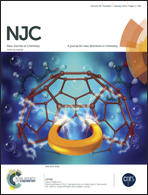Vesicular hydrogen silsesquioxane-mediated synthesis of nanocrystalline silicon dispersed in a mesoporous silica/suboxide matrix, with potential for electrochemical applications†
Abstract
Room temperature hydrolysis of triethoxysilane (TES) in the presence of pluronic P-123 (PEO20–PPO70–PEO20) triblock copolymer under acidic conditions resulted in the formation of soft nanoscale vesicles with thin (<10 nm) hydrogen silsesquioxane (HSiO1.5)n gel walls. FTIR and 29Si MAS NMR showed that pyrolysis of this material at 1000 °C in H2/Ar atmosphere led to decomposition of the hydrogen silsesquioxane with the resulting formation of a silicon suboxide surrounding Si nanocrystals, all embedded in a SiO2 matrix. SEM, TEM, BET and SAXS measurements showed that this vesicular Si@SiOx–SiO2 composite material had a high surface area and interconnected mesoporous structure. Nanocrystalline silicon was confirmed by XRD after the high temperature pyrolysis. An optimum in Li-ion battery half-cell performance was observed after the pyrolysis at 1000 °C, apparently attributable to the mesoporous structure and silicon nanocrystals. The effect of the polymer binders sodium carboxymethyl cellulose (CMC) and polyacrylic acid (PAA) on the cyclic performance was investigated by cyclic voltammetry and electrochemical impedance spectroscopy. Results suggest that the formation of the solid electrolyte interface layer is slower in the case of PAA, resulting in lower resistance to lithium diffusion at the interface.


 Please wait while we load your content...
Please wait while we load your content...